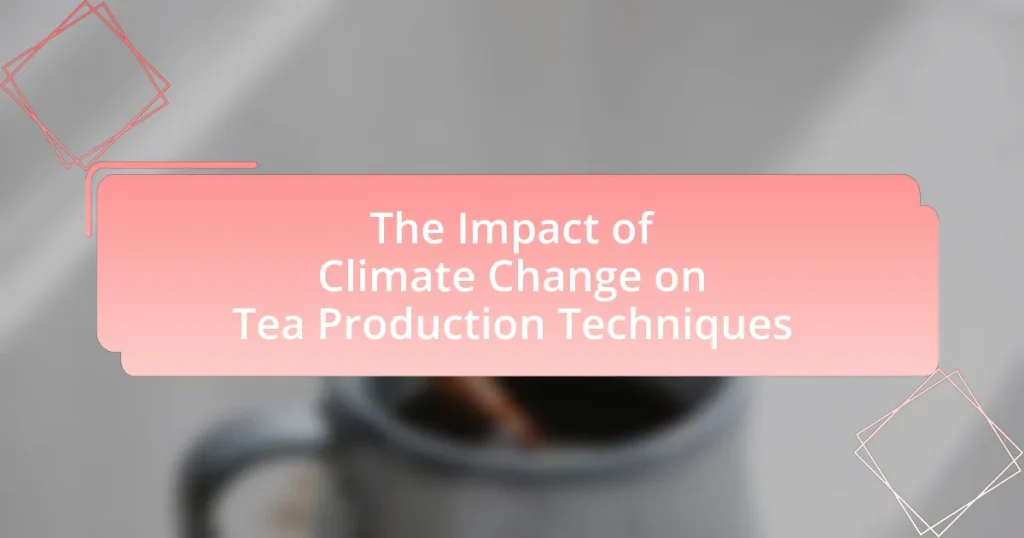The article examines the impact of climate change on tea production techniques, highlighting how rising temperatures, altered precipitation patterns, and increased pest dynamics affect cultivation practices and yields. It discusses specific climatic factors influencing tea growth, such as temperature, rainfall, and humidity, and outlines the economic implications of reduced yields and increased production costs. The article also explores how tea producers are adapting through sustainable practices, innovative technologies, and collaboration, while anticipating shifts in consumer preferences towards eco-friendly products. Overall, it emphasizes the urgent need for adaptation in the tea industry to ensure future viability amidst changing climate conditions.

What is the impact of climate change on tea production techniques?
Climate change significantly affects tea production techniques by altering growing conditions, pest dynamics, and water availability. Rising temperatures can lead to heat stress in tea plants, necessitating adjustments in cultivation practices such as shading and irrigation. Additionally, increased rainfall variability can cause soil erosion and affect the timing of tea harvesting, requiring farmers to adapt their schedules and methods. Research indicates that regions traditionally suitable for tea cultivation may become less viable, pushing producers to explore new areas or invest in climate-resilient varieties. For instance, a study published in the journal “Agricultural Systems” highlights that climate change could reduce suitable tea-growing areas by up to 50% by 2050, emphasizing the urgent need for adaptation in production techniques.
How does climate change affect tea cultivation practices?
Climate change significantly affects tea cultivation practices by altering temperature and precipitation patterns, which directly influence tea plant growth and yield. Increased temperatures can lead to heat stress in tea plants, reducing their quality and quantity. For instance, studies indicate that a rise of 1°C can decrease tea yields by up to 10%. Additionally, changing rainfall patterns can result in either drought or excessive moisture, both of which can adversely affect soil health and tea plant development. Research from the International Centre for Tropical Agriculture highlights that climate variability has already led to shifts in optimal growing regions for tea, necessitating adjustments in cultivation techniques to maintain productivity.
What specific climatic factors influence tea growth?
Temperature, rainfall, humidity, and altitude are the specific climatic factors that influence tea growth. Optimal temperatures for tea cultivation range between 20°C to 30°C, as extreme heat or cold can adversely affect plant health and yield. Rainfall is crucial, with tea plants requiring 1,200 to 2,500 mm of annual precipitation for optimal growth; insufficient rainfall can lead to drought stress, while excessive rainfall can cause root diseases. Humidity levels between 70% and 90% are ideal, as they promote healthy leaf development and reduce pest infestations. Additionally, altitude affects tea quality, with higher elevations generally producing teas with more complex flavors due to slower growth rates and cooler temperatures. These factors collectively determine the viability and productivity of tea plantations.
How do changes in temperature and precipitation affect tea yields?
Changes in temperature and precipitation significantly affect tea yields by altering growth conditions and plant health. Increased temperatures can lead to heat stress, reducing the quality and quantity of tea leaves, while insufficient or excessive precipitation can cause water stress or promote diseases, both of which negatively impact yield. For instance, research indicates that a 1°C rise in temperature can decrease tea yields by 10-20%, and erratic rainfall patterns can disrupt the critical growing seasons, further exacerbating yield losses.
What are the economic implications of climate change on tea production?
Climate change significantly impacts tea production economically by altering yield, quality, and market dynamics. Rising temperatures and changing precipitation patterns can lead to reduced crop yields; for instance, studies indicate that a 1°C increase in temperature could decrease tea yields by up to 20% in some regions. Additionally, climate change can affect the quality of tea, as higher temperatures may lead to increased pest and disease prevalence, further threatening production. These factors can drive up prices and reduce the competitiveness of tea in global markets, as countries that rely heavily on tea exports, such as India and Kenya, may face economic instability. The economic implications extend to farmers, who may experience decreased income and increased costs for adaptation measures, ultimately affecting the entire supply chain.
How does climate change impact the cost of tea production?
Climate change significantly increases the cost of tea production by affecting yield, quality, and resource availability. Rising temperatures and altered precipitation patterns lead to reduced tea yields, as optimal growing conditions are disrupted. For instance, a study published in the journal “Agricultural Systems” indicates that a 1°C increase in temperature can reduce tea yields by up to 10%. Additionally, climate change exacerbates pest and disease pressures, necessitating increased use of pesticides and other inputs, which further raises production costs. Water scarcity, driven by changing rainfall patterns, also forces producers to invest in irrigation systems, adding to overall expenses. These factors collectively contribute to higher costs for tea producers, impacting market prices and consumer affordability.
What are the potential market shifts due to climate change in the tea industry?
Climate change is likely to cause significant market shifts in the tea industry, primarily through altered production regions, changing consumer preferences, and fluctuating prices. As temperatures rise and precipitation patterns change, traditional tea-growing regions may become less viable, pushing producers to seek new areas with suitable climates, such as higher altitudes or different geographical locations. For instance, research indicates that regions in India and Sri Lanka may face reduced yields due to increased heat and drought, leading to a potential decline in supply.
Additionally, consumer preferences are shifting towards sustainably sourced and climate-resilient products, which could increase demand for organic and eco-friendly tea options. This shift is supported by a growing awareness of environmental issues among consumers, as evidenced by a report from the International Tea Committee, which highlights a rising trend in the consumption of specialty teas that emphasize sustainability.
Furthermore, the volatility in production due to climate impacts may lead to increased prices, as supply struggles to meet demand. Historical data shows that extreme weather events have previously caused price spikes in agricultural commodities, including tea. Thus, the tea industry must adapt to these changes to remain competitive and sustainable in a warming world.

How are tea producers adapting to climate change?
Tea producers are adapting to climate change by implementing sustainable agricultural practices and diversifying tea varieties. These adaptations include shifting planting dates, using drought-resistant tea cultivars, and employing agroforestry techniques to enhance resilience against extreme weather conditions. For instance, research indicates that integrating shade trees can help regulate temperature and moisture levels, thereby improving tea yield and quality. Additionally, producers are adopting precision farming technologies to optimize water usage and monitor soil health, which further supports their adaptation efforts.
What innovative techniques are being implemented in tea production?
Innovative techniques being implemented in tea production include precision agriculture, which utilizes data analytics and IoT devices to optimize growth conditions and resource use. This method allows farmers to monitor soil moisture, nutrient levels, and weather patterns in real-time, leading to improved yield and quality. Additionally, the use of climate-resilient tea varieties is gaining traction, as these plants are bred to withstand extreme weather conditions, thereby ensuring consistent production despite climate change challenges. Research from the International Tea Research Institute indicates that these techniques can increase productivity by up to 30% while reducing water usage by 20%.
How does the use of technology enhance resilience in tea farming?
The use of technology enhances resilience in tea farming by enabling farmers to monitor environmental conditions and optimize resource management. Precision agriculture technologies, such as soil sensors and climate monitoring systems, provide real-time data that helps farmers make informed decisions about irrigation, fertilization, and pest control. For instance, a study published in the Journal of Agricultural Science found that the implementation of precision irrigation systems can reduce water usage by up to 30% while maintaining crop yield, demonstrating how technology can mitigate the impacts of climate variability. Additionally, the use of drones for crop surveillance allows for early detection of diseases and pests, which can lead to timely interventions and reduced crop losses. These technological advancements collectively contribute to the sustainability and resilience of tea farming in the face of climate change.
What role do sustainable practices play in adapting to climate change?
Sustainable practices are essential in adapting to climate change as they enhance resilience and reduce vulnerability in agricultural systems, including tea production. By implementing methods such as organic farming, agroforestry, and water conservation, tea producers can mitigate the adverse effects of climate change, such as increased temperatures and erratic rainfall patterns. For instance, research from the International Centre for Tropical Agriculture indicates that sustainable practices can improve soil health and increase crop yields by up to 30%, thereby supporting farmers in maintaining productivity despite climatic challenges.
What are the challenges faced by tea producers in adapting to climate change?
Tea producers face significant challenges in adapting to climate change, primarily due to shifting weather patterns, increased pest and disease prevalence, and water scarcity. These factors disrupt traditional cultivation practices and threaten crop yields. For instance, rising temperatures can lead to altered growth cycles, affecting the quality and quantity of tea leaves produced. Additionally, extreme weather events, such as droughts or heavy rainfall, can damage tea plantations and reduce overall productivity. Research indicates that climate change could reduce tea yields by up to 50% in some regions by 2050, highlighting the urgency for producers to implement adaptive strategies.
How do financial constraints limit adaptation efforts?
Financial constraints limit adaptation efforts by restricting the availability of resources necessary for implementing new agricultural practices and technologies. For instance, tea producers facing financial limitations may lack the funds to invest in climate-resilient crop varieties, irrigation systems, or soil management techniques that could mitigate the impacts of climate change. Research indicates that smallholder farmers, who often operate under tight financial conditions, are less likely to adopt innovative practices due to the high upfront costs associated with these adaptations. A study by the International Fund for Agricultural Development (IFAD) highlights that inadequate financial resources can lead to a reliance on traditional methods, which may be less effective in the face of changing climate conditions, ultimately jeopardizing crop yields and sustainability.
What are the barriers to adopting new production techniques?
The barriers to adopting new production techniques in tea production include high initial costs, lack of technical knowledge, and resistance to change among farmers. High initial costs can deter farmers from investing in new technologies, as they may not have the financial resources or access to credit. Lack of technical knowledge prevents farmers from effectively implementing and managing new techniques, leading to suboptimal results. Resistance to change is often rooted in traditional practices and skepticism about the benefits of new methods, which can hinder the willingness to adopt innovations. These barriers are supported by studies indicating that financial constraints and educational gaps significantly impact the adoption of agricultural innovations in developing regions.

What future trends can be expected in tea production due to climate change?
Future trends in tea production due to climate change include shifts in cultivation regions, changes in tea varieties, and increased adoption of sustainable practices. As temperatures rise and precipitation patterns alter, traditional tea-growing areas may become less viable, prompting farmers to relocate to higher altitudes or cooler regions. For instance, research indicates that regions like Assam in India may face reduced yields, while areas in Nepal and parts of Africa could see increased suitability for tea cultivation. Additionally, climate change is driving the development of more resilient tea varieties that can withstand extreme weather conditions, such as drought or heavy rainfall. Furthermore, to mitigate the impacts of climate change, tea producers are increasingly adopting sustainable agricultural practices, including organic farming and agroforestry, which enhance soil health and biodiversity. These trends reflect a necessary adaptation to ensure the future viability of tea production in a changing climate.
How might consumer preferences shift in response to climate change impacts?
Consumer preferences may shift towards more sustainable and eco-friendly products in response to climate change impacts. As awareness of climate-related issues increases, consumers are likely to prioritize products that demonstrate environmental responsibility, such as organic tea or those sourced from sustainable farming practices. Research indicates that 66% of global consumers are willing to pay more for sustainable brands, reflecting a significant trend towards eco-conscious purchasing decisions. This shift is driven by a growing understanding of the environmental consequences of traditional production methods, particularly in industries like tea, which are vulnerable to climate variability.
What types of tea are likely to become more popular as conditions change?
Herbal teas, particularly those made from adaptogenic herbs like ashwagandha and holy basil, are likely to become more popular as climate conditions change. These teas are favored for their health benefits, including stress reduction and immune support, which are increasingly sought after in a world facing climate-related challenges. Additionally, teas that can be cultivated in diverse climates, such as rooibos and hibiscus, may gain traction due to their resilience to varying environmental conditions. The growing consumer interest in wellness and sustainability further supports the rise of these tea types, as they align with trends towards health-conscious and eco-friendly choices.
How can producers anticipate and respond to changing consumer demands?
Producers can anticipate and respond to changing consumer demands by utilizing market research and trend analysis to identify shifts in consumer preferences. For instance, data from the Tea Association of the USA indicates that consumers increasingly prefer organic and sustainably sourced tea, prompting producers to adapt their cultivation practices accordingly. By implementing sustainable farming techniques and enhancing product transparency, producers can align their offerings with consumer values, thereby increasing market competitiveness. Additionally, engaging with consumers through social media and feedback mechanisms allows producers to gather insights directly, enabling them to make informed adjustments to their product lines in real-time.
What best practices can tea producers adopt to mitigate climate change effects?
Tea producers can adopt agroforestry practices to mitigate climate change effects. By integrating trees into tea plantations, producers enhance biodiversity, improve soil health, and increase carbon sequestration. Research indicates that agroforestry systems can sequester up to 30% more carbon compared to monoculture systems, thereby reducing greenhouse gas emissions. Additionally, implementing water conservation techniques, such as rainwater harvesting and drip irrigation, can help manage water resources more efficiently, which is crucial as climate change alters precipitation patterns. Furthermore, utilizing climate-resilient tea varieties can enhance crop resilience to temperature fluctuations and extreme weather events, ensuring sustainable production.
What strategies can enhance sustainability in tea production?
Implementing agroecological practices enhances sustainability in tea production. These practices include crop diversification, organic farming, and integrated pest management, which reduce reliance on chemical inputs and promote biodiversity. Research indicates that agroecological methods can increase soil health and resilience to climate change, leading to improved yields and reduced environmental impact. For instance, a study published in the journal “Agriculture, Ecosystems & Environment” found that organic tea farms had 20% higher biodiversity compared to conventional farms, demonstrating the effectiveness of sustainable practices in enhancing ecological balance.
How can collaboration among producers improve resilience to climate change?
Collaboration among producers can significantly improve resilience to climate change by enabling shared resources, knowledge, and strategies. When tea producers work together, they can implement collective practices such as water conservation techniques, pest management, and crop diversification, which are essential in adapting to changing climate conditions. For instance, a study by the International Tea Committee highlights that collaborative efforts in research and development can lead to the adoption of climate-resilient tea varieties, enhancing yield stability despite adverse weather events. Additionally, joint initiatives can facilitate access to funding and technology, further strengthening the capacity of producers to withstand climate-related challenges.


